- Get link
- X
- Other Apps
- Get link
- X
- Other Apps

If we are talking about space colonies, then the first thing that comes to mind is, of course, Mars. On the Red Planet, we have been looking more than one millennium and, it seems, will soon fly there. The aerospace agency NASA and several private companies are taking serious steps to ensure that mankind begins the colonization of Mars in the next decades.
Nevertheless, in the solar system there are several satellites of the planets, which are also suitable for colonization in the near future. And the presence of traces of water on some of them only increases the chances of this possibility. Today we will talk about 10 such satellites.
Europe

There are good reasons to believe that people will not only be able to survive on Europe, the satellite of Jupiter, but they will find there already existing life. Europe is covered with a thick ice crust, but many scientists tend to believe that under it is a real ocean of liquid water. In addition, the presence of a solid inner core in Europe adds to the chances of having the right environment to support life, whether it be ordinary microbes or, perhaps, even more complex organisms.
To study Europe for the existence of conditions for the existence of life and life itself is definitely worth it. After all, this will greatly increase the chances of a possible colonization of this world. NASA wants to check whether the water of Europe has any connection with the core of the planet and whether this reaction produces heat and hydrogen, as we have on Earth. In turn, the study of various oxidants that may be present in the ice cake of the planet will indicate the level of oxygen produced, as well as how much it is closer to the ocean floor.
There are prerequisites to believe that NASA will be engaged in a dense study of Europe and attempts to fly there somewhere by 2025. It is then that we will find out whether the theories that are associated with this ice companion are true. The study on the ground can also show the presence of active volcanoes under the ice surface, which, in turn, will also increase the chances of life on this satellite. Because these volcanoes in the ocean can accumulate the most important minerals.
Titanium

Despite the fact that Titan, one of the satellites of Saturn, is in the outer boundary of the solar system, this world is one of the most interesting places for mankind and, probably, one of the candidates for future colonization.
Of course, breathing here will require the use of special equipment (the atmosphere is unsuitable for us), but there is no need to use special spacesuits with controlled pressure. However, to wear special protective clothing, of course, still have to, since there is a very low temperature, often dropping to -179 degrees Celsius. The strength of gravity on this satellite is just below the level of gravity on the Moon, which means it will be relatively easy to walk on the surface.
It will be necessary, however, to seriously consider how to grow the crop, and take care of the issues of artificial lighting, since the sunlight on Titan falls only 1/300 to 1/1000 of the earth's level. Dense clouds are responsible for everything, which, nevertheless, protect the satellite from excessive levels of radiation.
On Titan there is no water, but there are whole oceans from liquid methane. In this regard, some scholars continue to argue over whether life could have formed under such conditions. Whatever it was, Titan has something to explore. There are countless methane rivers and lakes, large mountains. In addition, there should be simply amazing views. In view of the relative proximity of Titan to Saturn, the planet in the sky of the satellite (depending on the cloudiness) occupies up to one third of the sky.
Miranda
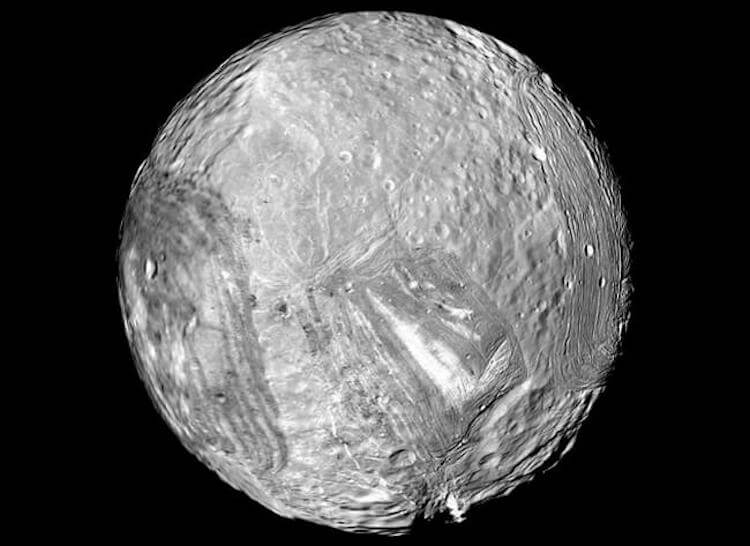
Despite the fact that the largest satellite of Uranus is Titania, Miranda, the smallest of the five moons of the planet, is most suitable for colonization. There are some very deep canyons on Miranda, deeper than the Grand Canyon on Earth. These places can be an ideal place for planting and installing a base that will be protected from the external impact of a harsh environment and especially from radioactive particles produced by the magnetosphere of Uranus itself.
There is ice on Miranda. Astronomers and researchers estimated that it is about half the composition of this satellite. As in Europe, there is a likelihood of water on the satellite, which is hidden under the ice cap. Surely this is unknown, and we will not know until we get closer to Miranda. If there is still water on Miranda, this would indicate a serious geological activity on the satellite, since it is too far from the Sun and sunlight is not able to maintain water here in liquid form. Geological activity, in turn, would explain all this. Despite the fact that this is just a theory (and, most likely, unlikely), Miranda's proximity to Uranus and its tidal forces can cause this very geological activity.
Whether there is water in liquid form or not, but if we install a colony on Miranda, the very low gravity of the satellite will allow us to descend into deep canyons without fatal consequences. In general, here too it will be what to do and what to investigate.
Enceladus

According to some researchers, Enceladus, one of the satellites of Saturn, can not only become an excellent place for colonization and observation of the planet, but is almost the most likely place that already supports life.
Enceladus is covered with ice, but observations with probes from outer space have shown geological activity on the moon and, in particular, geysers escaping from its surface. The Cassini spacecraft collected samples and determined the presence of liquid water, nitrogen and organic carbon. These elements, as well as the source of energy that threw them into space, are important "bricks of life." Therefore, the next step for scientists will be the discovery of signs of more complex elements and, possibly, organisms that may be hiding under the icy surface of Enceladus.
Researchers believe that the best place to install the colony will be the zones next to which these geysers were seen - huge faults on the surface of the ice cap of the south pole. A very unusual thermal activity is observed here, equivalent to the operation of about 20 coal-fired power plants. In other words, for future colonists there is a suitable source of heat.
On Enceladus there are many craters and faults, just waiting to be explored. Unfortunately, the atmosphere of the satellite is very low, and low gravity can create some problems in mastering this world.
Charon
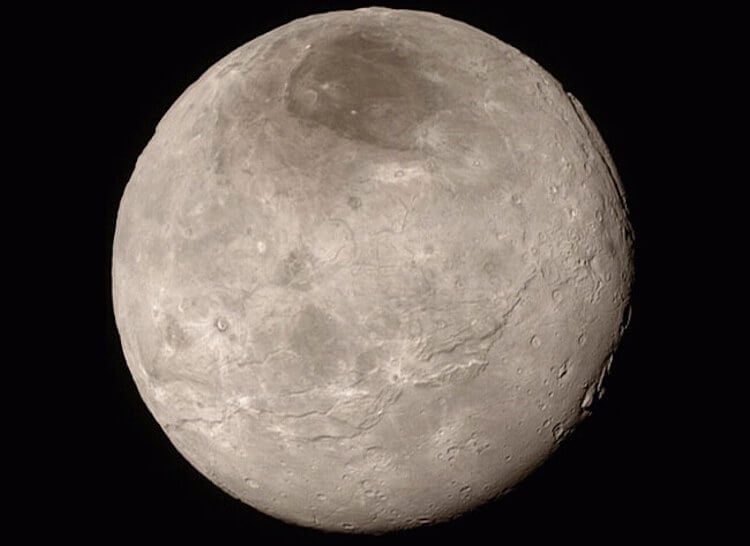
NASA's "New Horizons" after the meeting with Pluto sent to Earth stunning images of a dwarf planet and its largest satellite Charon. These images provoked heated debate in the scientific community, which is now trying to determine whether the satellite is geologically active. It turned out that the surface of Charon (as well as Pluto) is much younger than previously thought.
Despite the fact that there are cracks in the surface of Charon, it seems that this moon very effectively avoids collision with asteroids, since it has very few impact craters. The cracks and faults themselves are very similar to those that remain from the flow of hot lava. The same cracks were found on the Moon and are an ideal place to install a colony.
It is believed that Charon has a very dilute atmosphere, which can also be an indicator of geological activity.
Mimas
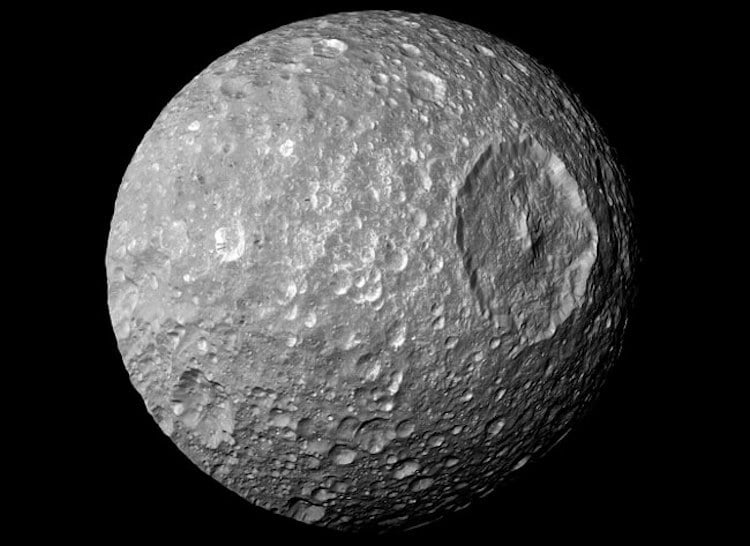
Mimas is often called the "Star of Death." It is possible that under the ice cap of this satellite can hide the ocean. And despite the general sinister look of this moon, it probably can really be suitable for sustaining life. Observations of the Cassini space probe showed that Mimas is slightly swinging in its orbit, which could speak of geological activity under its surface.
And although scientists are very cautious in their assumptions, there were no other traces that would indicate the geological activity of the satellite. If an ocean is discovered on Mimas, then this moon should be considered one of the first to be the most suitable candidate for setting up a colony here. Approximate calculations indicate that the ocean can be hidden at a depth of about 24-29 kilometers below the surface.
If the unusual orbital behavior is in no way connected with the presence of liquid water under the surface of this satellite, then, most likely, it's all about its deformed core. And blame for this is the strong gravitational pool of Saturn's rings. Whatever it was, the most obvious and the most reliable way to find out what is happening here is landing on the surface and carrying out the necessary measurements.
Triton
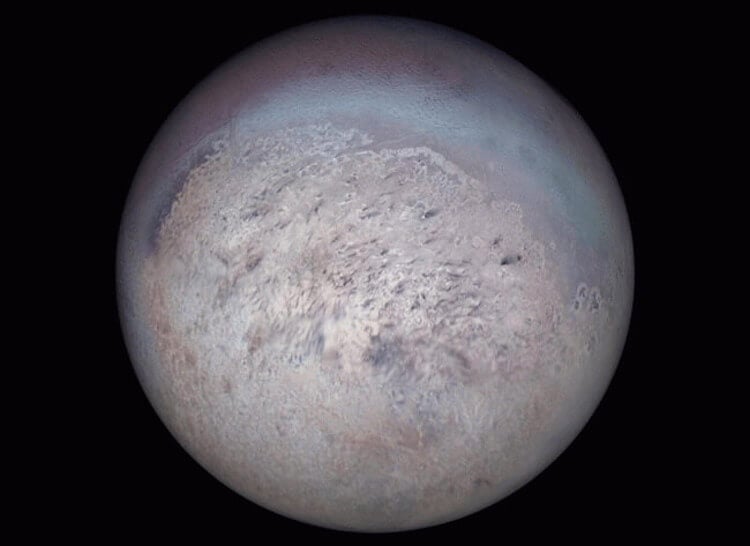
Images and data obtained from the spacecraft Voyager 2 in August 1989 showed that the surface of the largest satellite of Neptune, Triton, consists of rocks and nitrogen ice. In addition, the data hinted that there might be liquid water under the surface of the satellite.
Although Triton has an atmosphere, it is so empty that on the surface of the satellite from it there is no sense. To be here without a specially protected suit - death is like. The average temperature on the surface of Triton is -235 degrees Celsius, which makes this moon the coldest space object in the known universe.
Nevertheless for scientists Triton is very interesting. And one day they would like to get there, establish a base and conduct all the necessary scientific observations and research:
"Some areas of the Triton surface reflect light, as if made of something solid and smooth, like metal. It is believed that these areas contain dust, nitrogen gas and, possibly, water that seeps through the surface and instantly freezes as a result of an incredibly low temperature. "
In addition, the scientists calculated that Triton was formed around the same time and from the same material as Neptune, which is very strange given the size of the satellite. It seems that it was formed somewhere in another corner of the solar system, and then was attracted by the gravity of Neptune. Moreover, the satellite rotates in the opposite direction to its planet. Triton is the only satellite of the solar system, which has this feature.
Ganymede
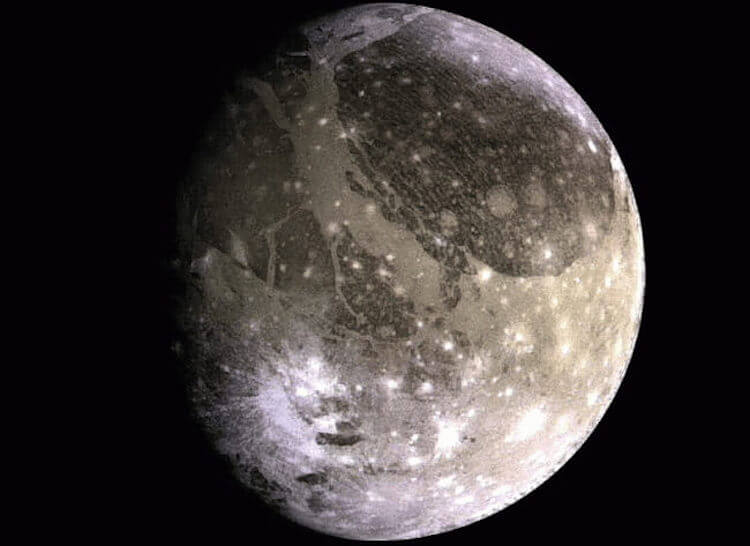
With regard to the largest satellite of Jupiter, Ganymede, as well as other space objects in our solar system, suspicions were expressed about the presence of water under the surface. Compared to other ice-covered satellites, the surface of Ganymede is generally considered relatively thin and easy to drill.
In addition, Ganymede is the only satellite in the solar system, which has its own magnetic field. Due to this, over its polar regions one can very often observe the northern lights. In addition, there are suspicions that a liquid ocean can hide beneath the surface of Ganymede. The satellite has a depleted atmosphere, which includes oxygen. And although it is extremely small to maintain the life that we know, there is a potential for terraforming from the satellite.
In 2012, the European Space Agency planned a space mission to Ganymede, as well as two other satellites of Jupiter - Callisto and Europe. The launch is planned to be carried out in 2022. Get to Ganymede 10 years later. Although all three satellites are of great interest to scientists, it is believed that Ganymede contains the largest number of interesting features of science and is potentially suitable for colonization.
Callisto
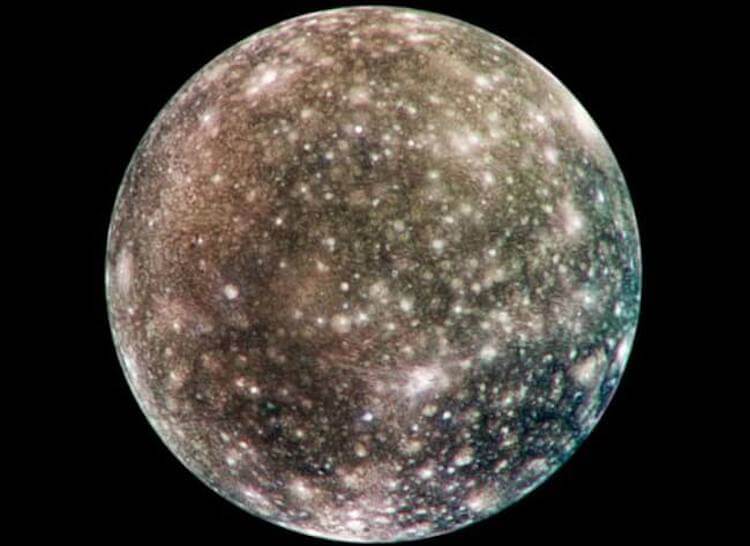
The size of the planet Mercury, the second largest satellite of Jupiter is Callisto - another moon, in relation to which the assumptions about the water content under the ice surface are expressed. In addition, the satellite is considered as a suitable candidate for future colonization.
The surface of Callisto basically consists of craters and ice fields. The atmosphere of the satellite is a mixture of carbon dioxide. Scientists are already suggesting that a very thin atmosphere of the satellite is replenished with carbon dioxide, escaping from under the surface. The previously obtained data indicated the possibility of the presence of oxygen in the atmosphere, but further observations did not confirm this information.
Since Callisto is at a safe distance from Jupiter, the radiation from the planet will be relatively low. And the lack of geological activity makes the satellite environment more stable for potential colonists. In other words, it is possible to build a colony on the surface, and not under it, as in many cases with other satellites.
Moon

So we got to the first potential colony, which humanity will establish outside its planet. Speech, of course, is about our Moon. Many scientists are inclined to believe that the colony on our natural satellite will appear in the next decade and soon after that the Moon will become the starting point for more distant space missions.
Chris Mackay, NASA astrobiologist, is one of those who believe that the Moon is the most likely place for the first space colony of people. Mackay is confident that the further development of the Moon with the space mission after the Apollo 17 did not continue solely because of the cost of this program. However, current technologies developed for use on the Earth can also be very economical for use in space and significantly reduce the cost of the launches themselves, as well as construction on the surface of the moon.
Despite the fact that now the biggest mission for NASA is the landing of a man on Mars, Mackey is confident that this plan will not be implemented until the moment when the first lunar base appears on the Moon, which will become the starting point for further missions to the Red Planet. Not only many states, but also many private companies are interested in colonization of the Moon and even prepare corresponding plans.
The article is based on materials .
- Get link
- X
- Other Apps
Comments
Post a Comment